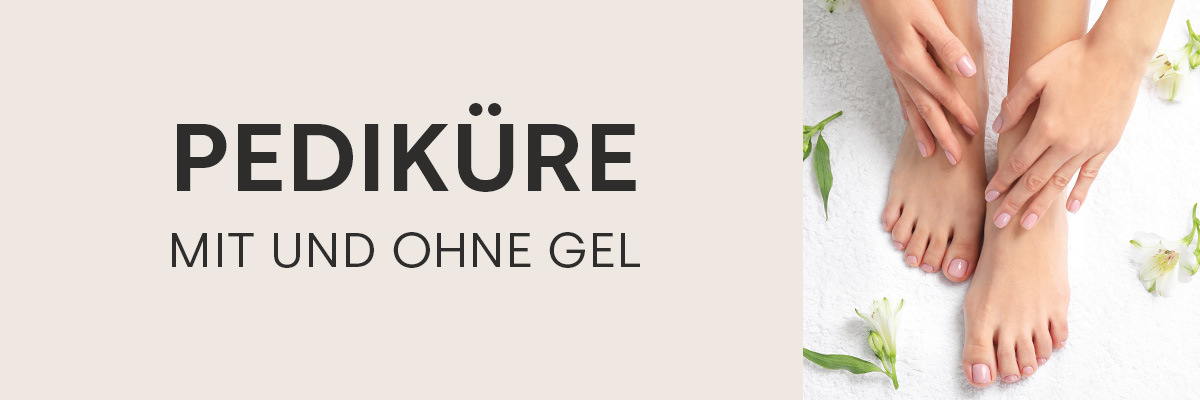Foot care guide


If you want to do something good for your feet, spend a little time with them. Cosmetic foot care is something you can easily do at home. All you need is a few utensils and a little time. We'll show you how to do the perfect pedicure at home.
What is a pedicure?
Pedicure comes from the Latin word "pes", which translates as "foot". In contrast, there is the "manicure", i.e. the care of the hands. A distinction is made between cosmetic and medical pedicures. But what is done during foot care? Cosmetic foot care is mainly concerned with
- Foot bath
- Exfoliation
- Removing calluses
- Cutting toenails
- Apply cream
Cosmetic foot care can easily be done at home. However, corns, nail fungus, ingrown and inflamed toenails should be treated by a podiatrist. Problem areas on the feet associated with diabetes should also be treated by a specialist.
How does the pedicure work at home?
Step 1: Foot bath
A pleasant foot bath softens chapped areas on the foot and the toenails become softer. Nail polish is best removed beforehand with nail polish remover and nail wipes. Dirt is best removed with a little shower gel or soap. Do not forget the areas between the toes. The water should be between 36°C and 40°C; soak your feet for a maximum of 10 minutes. If you like, add a little lavender oil, lemon juice or apple cider vinegar to the water to make it easier to remove the calluses later. For smoother feet, choose a bath additive with salicylic acid or a mixture of olive oil and coarse sea salt. Mint or rosemary provide a freshness boost.
Step 2: Exfoliation
A scrub removes dead skin cells from the feet. You can either use our hand scrub or make your own using two parts olive oil and one part coarse sea salt or sugar. The scrub is then massaged in using circular movements and removes the first calluses.
Step 3: Remove calluses
For normal calluses, the scrub is usually sufficient. You can now use a pumice stone, a callus rasp or a callus file to gently remove any remaining calluses. Please do not work too deeply, but very carefully. Calluses are a protective mechanism; the more stress is placed on the area, the more calluses grow back. Therefore, the file or rasp should only be used every two weeks to prevent more callus growth. If you have problems with stubborn calluses, you can seek advice on special products at the pharmacy.
Step 4: Cut toenails
To prevent ingrown toenails and nail bed inflammation, it is important to cut the toenails straight across. Even if it may seem a little strange at first because you may be filing your fingernails in a different shape, it makes medical sense to make sure they are the right shape. Whether nail scissors or nail clippers are better is something everyone has to try out for themselves. The important thing is that you know how to use them well and follow these tips:
- Do not shorten nails too much; the nail corners should rest freely on the side edge of the skin.
- Keep the corners of the toenails straight and do not round them off.
- Do not file the nails to a point, but make sure they are straight.
- The edge of the nail can be smoothed with a file at the end. To do this, place the file gently on the upper edge of the nail
- Edge of the nail and file downwards away from the toe, rounding off the cut edge from top to bottom.
Step 5: Remove cuticles
Excess cuticles form on the feet in particular due to the strain caused by tight shoes or the friction of socks. To prevent these dead skin parts from tearing and causing painful inflammation, they should be removed regularly. Cuticles are best pushed back with a rosewood stick and carefully clipped off. Find out more about cuticle removal here.
How do you do a pedicure with nail polish?
After the toenails have dried well, we treat ourselves to another dose of color. But how does the nail polish color last as long as possible? From experience, it is best to apply the nail polish pedicure the next day, as the toenails have absorbed a lot of moisture from the treatment and the nail polish only lasts well on dry and oil-free nails. To avoid any mishaps, use the toe separator to ensure a safe distance between the toes. We then prime the toenails with our 6 in 1 clear nail polish. The base coat acts as a groove filler, smoothing out small irregularities on the nail and providing the perfect base for polishing. After drying, the colored polish is applied. Once the first coat has dried well, apply a second coat for a more intense color result. Now our Allrounder lacquer is used again as a quick dryer and sealer to ensure that the color lasts a long time and does not chip. Your well-groomed and beautiful toenails are finished with a nail polish pedicure.
Strengthen natural nails with gel
Natural nail gel can be applied to thin and brittle nails. If you are using gel to strengthen natural nails for the first time, you should definitely familiarize yourself with the material and its chemical properties. Light-curing gel consists of so-called monomers and acrylates. Monomers are small molecules that join together to form long chains when exposed to a trigger such as an LED lamp. This usually results in a slight build-up of heat and a sticky layer, the so-called inhibition layer. The products for natural nail enhancement with gel are composed in the same way as dental fillings. They are harmless to health. If you want to strengthen natural nails with gel, you should ensure that it is applied correctly:
- Prepare the natural nail and coat with a buffer.
- For problem nails: Apply Emmi-Nail Prep&Prime and allow to air dry briefly and also apply our Emmi-Nail Base Coat S2
- Apply Emmi-Nail Rubber Base like nail polish and cure (120 sec. under UV/LED or 120 sec. UV light)
- For an extension or reinforcement, apply the Rubber Base again and cure again.
- Do not apply the gel too thickly, rather work in 2 or more coats and allow it to harden in between.
- Now apply an Emmi-Nail UV polish or quickie as desired and allow it to harden.
- The Emmi-Nail UV/LED lacquer base/top coat is used as a sealant. (no sealant is required for the Quickies as these varnishes cure without an inhibition layer)
- After curing, remove the inhibition layer with the High-Gloss Cleaner.
How long does a nail enhancement last?
The product determines how long a natural nail enhancement with gel lasts. UV nail polishes last up to three weeks and can be removed with remover. Conventional gel nails can be refilled after two to three weeks and in principle reinforce the nail indefinitely until the gel is filed off. As the Nature series is a UV gel, it cannot simply be removed with a liquid. However, the reinforcement looks so natural that you can simply let it grow out as required.
The modeling is very stable and the gels are still easy to file. Nature gels are also ideal for refilling gel nails that have grown out. Our range of nail gels in a bottle includes a base gel, three colored build-up gels and a sealing gel.
Video tutorial Rubber Base Gel
Our range of natural nail gels
Our new emmi®NAIL Nature gels in the practical brush bottle are perfect for giving natural nail enhancements a natural look. Thanks to their simple, quick and clean application, they make everyday studio work easier and can also be used at home. You have a brush at hand for each gel, which is protected from dirt, dust and UV radiation in the bottle.
With emmi®Nail, you benefit from many years of experience that has gone into the development of our professional nail design products. The natural nail gel has a beautiful coloration and convinces all customers who love the natural look. If you would like to enhance your natural nails with gel, you can now conveniently order on account in our online store.




